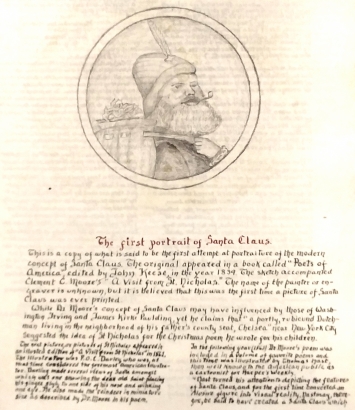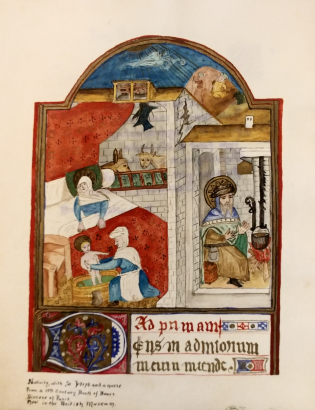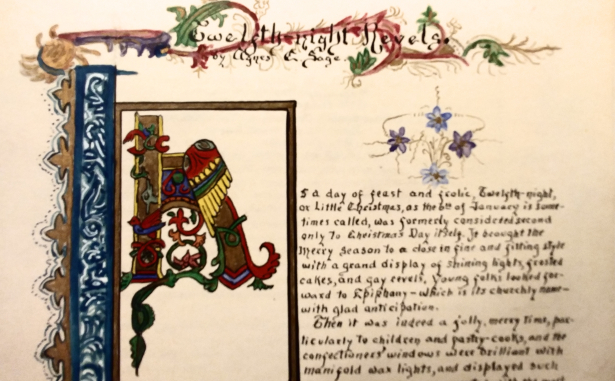Earlier this year, the acquisitions staff at the Western History and Genealogy Department was approached with a donation of a rather unusual book written about the history of Christmas. Suffice to say, there are very few volumes of Christmas lore in the Western History Collection and even fewer in our Rare Books and Douglas Fine Printing Collections. We didn't quite know what to expect after hearing the description of the book over the phone, but what we received in the mail truly blew us away.
The volume was tucked in a padded Christmas box lined in festive wrapping paper which revealed a handmade wooden box with a carving of Santa Claus on the outside. The book itself was handbound and contained within hand-trimmed leather covers. Its title, A History of the Feast of Christmas, understated both the density and beauty of the work housed between its covers.
A History of the Feast of Christmas was compiled by Denverite Jean Allard Jeançon between 1932 and 1934. It contains well over 200 handwritten and handpainted pages which take a deep dive into everything from Christmas-themed magic spells to the origins of Christmas carols and other traditions. The book even has sheet music for a few Christmas carols Jeançon wrote himself. But the real stars of the show are Jeançon's lovingly rendered copies of classic illuminated manuscripts (as pictured above). These illustrations, of which there are many, are absolutely stunning and truly make this book a one-of-a-kind piece of art.
But A History of the Feast of Christmas is every bit as informative as it is beautiful.
That's because Jeançon wasn't just your run-of-the-mill, DIY bookmaker. He was also an accomplished anthropologist who wrote multiple volumes on Southwestern Indian tribes and served in a high-ranking post at the Smithsonian Institution. His surviving papers and several of his books are housed in a manuscript collection right here at Denver Public Library. In his private work, Jeançon combined a scholar's grasp of facts with an unadulterated love of Christmas to create a labor of love that is sure to have consumed thousands of hours of his life.
So what motivated Jeançon to spend so much time on a project that wasn't likely to have a wide audience?
Jeançon seems to have been driven by a scholar's insatiable desire to learn and disseminate information, as well as an unabashed love of all things Christmas, as he clearly states in the book's introduction:
Having a very large "child complex", and loving Fairie Tales, Christmas, Birthdays and other ancient festivals I have here compiled material concerning the Glorious Celebration of the Anniversary of the Birth of Our Saviour for the enjoyment of all children, young and old. For years I have accumulated data on the subject and have now put it in such form as to be available for use.
Jeançon never made clear who the audience was for his book, although we know from other items in the Jeançon collection that he was in the habit of lending out his work to friends and colleagues. Found tucked in the pages of the book was a June 22, 1934, letter from Denver stationary store owner Harry E. Bellamy.
After viewing the book, Bellamy opined,
We have greatly enjoyed it from many points of view - its beauty and its ancient look that make it an embodiment of precious tradition and its research into vast sources of human joy and its exquisite patterns and illuminations are instructive and beautiful as its text.
To say that A History of the Feast of Christmas drew from a wide variety of materials is something of an understatement. Poets of America by John Keese (1839) was used to create the piece on the first portrait of Santa Claus (pictured above), and Egyptian Secrets by Albertus Manus (published "sometime in the 12th Century," according to Jeançon) was utilized in a section titled, "Christmas Magic Spells." (pictured below)
What kind of Christmas spells did Jeançon glean from a book of ancient Egyptian secrets? How about a technique for saving cattle from putrid fever that involves a stick and incantations uttered on Christmas? Or maybe you'd prefer a method for compelling an animal to follow you that must be spoken into the animal's right ear?
Despite his formidable experience as an anthropologist, Jeançon never really explained how a series of Christmas spells originated from a book of Egyptian spells. But, as someone who believed so much in the magic of Christmas, he may just have let that one slide.
Besides Christmas-themed cures for ill cattle, Jeançon included several Christmas carols he penned himself. In short, A History of the Feast of Christmas is an incredibly dense volume that could only have been created by an erudite Christmas-lover like Jeançon.
Sadly, Jeançon didn't get much of an opportunity to share his Christmas work with an audience outside of a few friends and family members. He died of heart disease in April 1936, shortly after completing a 1,000-page tome on the Indians of the Southwest for the Smithsonian Institution. The accomplished anthropologist left behind a widow, a stepson and a lifetime of scholarly works.
The Denver Public Library is honored to house Jeançon's works and share them with our customers. To that end, we are putting A History of the Feast of Christmas on display in the Western History and Genealogy Department (WHG) from Tuesday, December 17, through Friday, January 4. WHG is open the same hours as the rest of Central Branch and no appointment is required.
We hope that viewers of Jeançon's work are inspired to research, learn and share—just as Jeançon himself was.







Comments
This was a great story and a
This was a great story and a treat! I enjoyed the pictures and history of this anthropologist. I hope to view his works.
Pamela
Thanks for the kind words,
Thanks for the kind words, Pamela! The History of the Feast of Christmas is available for viewing anytime the library is open and we've the opportunity to show it to you some time!
Add new comment